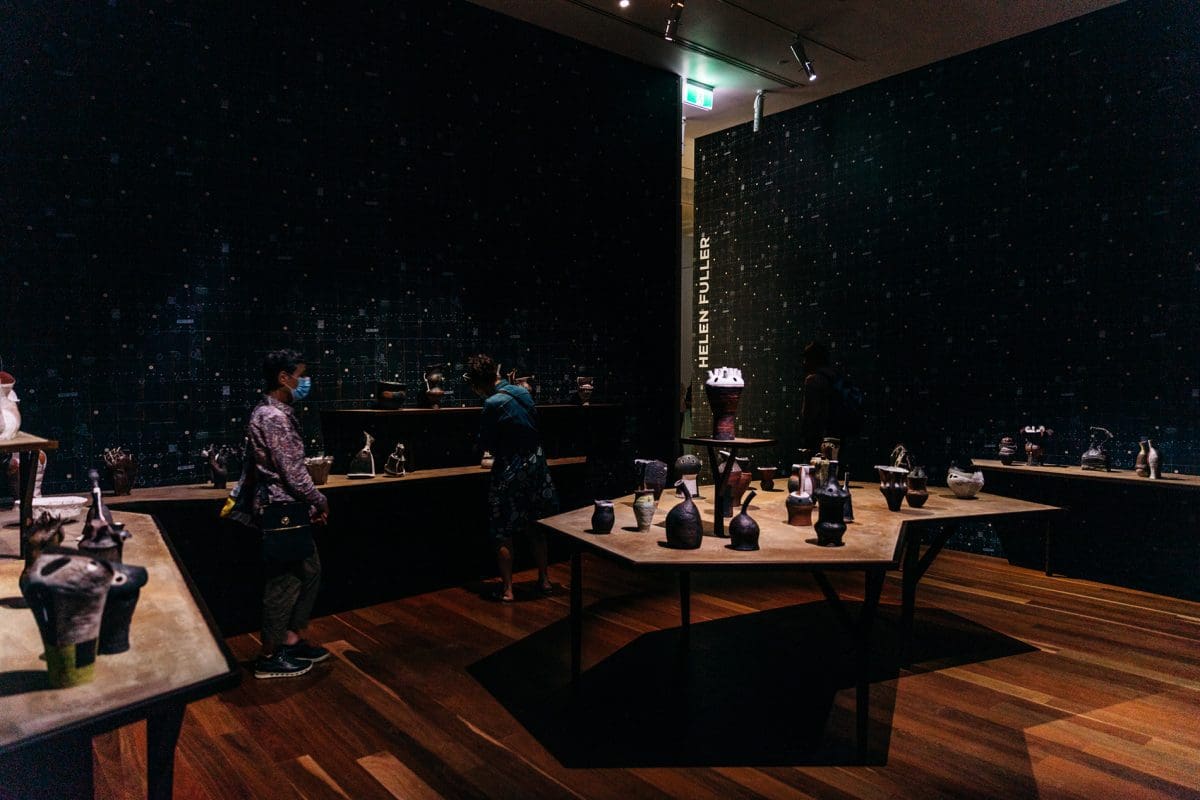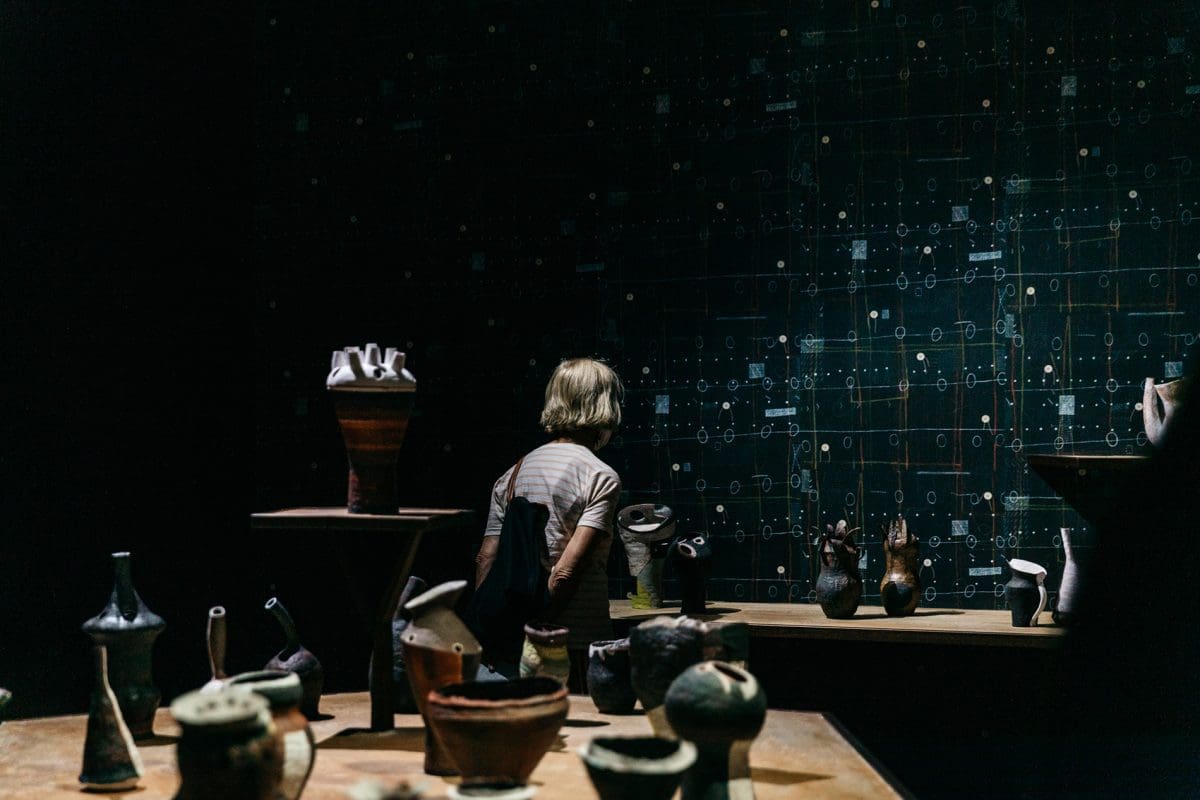
Piercing the veil
A new exhibition at Buxton Contemporary finds a rich complexity in the shadowy terrain between life and death.

Helen Fuller with Khai Liew, 2022, installation view, Samstag Museum of Art. Photograph by Grant Hancock.

Helen Fuller with Khai Liew, 2022, installation view, Samstag Museum of Art. Photograph by Grant Hancock.

Helen Fuller with Khai Liew, 2022, installation view, Samstag Museum of Art. Photograph by Sia Duff.

Helen Fuller with Khai Liew, 2022, installation view, Samstag Museum of Art. Photograph by Sia Duff.
South Australian artist Helen Fuller has spent much of her four-decade career working with painting, installation and sculpture. Beginning with her first exhibition in 1977, Fuller’s creativity has taken her across the globe on residencies in China and the Philippines, to a chance meeting with American composer John Cage in Berlin. In 2009 Fuller attended a local pottery class and has since used the tactile medium to create hand-built forms and coil pots with an organic edge. Tracing the origins of her aesthetic to a childhood full of backyard exploring, a fascination with archaeological digs and the diverse textures found in nature, Fuller spoke with Briony Downes about how these elements connect to her latest body of work at Samstag Museum of Art, and her collaboration with designer Khai Liew.
Briony Downes: How did your current exhibition at the Samstag Museum of Art come to be?
Helen Fuller: When Erica Green [Director of Samstag Museum of Art] invited me to put together an exhibition for the Adelaide Festival, one of the first things I did was approach furniture designer Khai Liew to see if I could borrow a piece of his fabricated furniture. His designs are very crisp and geometric while my pots are organic and a bit wonky. I had the idea that using Khai’s furniture as a plinth could compliment the structural imbalances of my work while also visually demonstrating the differences in our work.
Khai came to my studio and saw my pots stashed away in a cupboard and ended up deciding to design the entire installation for me. He was very proactive with the selection and placement of the works in the exhibition, designing the plinths and using one of my paintings as the foundation of the wallpaper design. The original painting actually contains buttons from my grandmother’s button jar that I’ve kept for years but when viewed in the large, repetitive format in the gallery, they ended up looking like stars. The combination of Khai’s design and my pots makes me feel like I’m in a night garden, like being under a vast night sky in the Flinders Ranges. I brought in about 80-90 pots I had completed throughout 2021 and 2022 and then my friend and fellow ceramicist Kirsten Coelho also got involved in the installation and placement. It really became a group effort.
BD: What was the creative process behind making the pots in this exhibition?
HF: They are all hand-built terracotta pots, I didn’t have a plan, it was like each pot I made grew out of my hands. For the textures I sourced leaf litter and seed pods while walking my dog. Also, native flora and eucalyptus leaves: I like the bark on the eucalyptus trees.
BD: How do you apply these textures to the terracotta?
HF: I have a big basket of leaf litter that I pilfer from. I press each texture into the terracotta when it’s still soft to create an imprint. I repeat these imprints, so they don’t look like what they were and it’s not clear where the texture is from. If it’s a leaf or stick, I’ll cut the debris off to make a shape I am curious about. At the moment I am using bark chips as you can break them into different sections. Then I use oxides and underglaze to get the natural earth colours, it’s very subtle colour. Khai really responded to this and all across the surface of the plinths he used clay to create an earthy texture. Glazing makes the forms too glassy for me. I see my pots more like still life. With the matt texture of the clay, the oxides give me a fundamental way of colouring. Sometimes I use a white porcelain slip that Kirsten passes on from her slop bucket and I just slip, slop, slap the porcelain onto the terracotta as another colour. I like my colour range to be fairly minimal and earthy.
BD: The Samstag Museum exhibition statement mentions your work possesses “connections to geological and social time”. Can you unpack this idea?
HF: In the past I’ve gone on archaeologist digs with friends. Some of the things we would find were ancient while others were fragments of modern human presence—ceramic plates and things like that. It was a combination of the ancient and new. We also used to go camping in the bush and the desert to just hang out in nature, it gave me a love for the ‘big sky’ out at the Flinders Ranges. I also like going to tip sites, it’s that rustic, earthiness I like. My aesthetic feeds from those found materials from being on site.
BD: That reference to the ancient object also connects to Coil Pots, your 2020 solo exhibition at Stanley Street Gallery in Sydney which was based on your fascination with fossils. When did you first discover a love for fossils?
HF: That goes back to childhood, my brother and I were always off exploring outside, down in the dirt, collecting leaves. Later in life, I worked in the bookshop at the South Australian Museum and there were always wonderful fossils coming into the shop to be sold. Also, a jeweler friend Regine Schwarzer, would cut and set stones in her work and we would go to rock festivals together, and people would be trading their finds from the desert. I found it really fascinating, especially how the fossils were often still embedded in clay and layers of slate. At home I have lots of fossils I have bought and collected over time. I have some fossils from a site in New South Wales and these contain a lot of leaf litter but the colours are really stunning. One piece is very rustic, there are these big lovely grey and beige leaf shapes trapped inside. Then there’s some nautilus fossils from overseas too. It’s about ancient history.
When I first started making pots I wasn’t looking at contemporary ceramics. By accident I found a book on Japanese Jōmon pottery from the Neolithic period and it blew me away as it was all hand-built. Beautiful forms that were quite organic. There is an absence of ego in these objects, they were pots built to do a job. Sometimes the maker used imprints of cord across the surface as decoration and I found this way of working really inspiring.
BD: It seems like your clay work is very much connected to place—from the materials you collect and how you use them.
HF: The terracotta clay I use is from Bennetts Magill Pottery and it’s quarried north of Adelaide. It’s really ancient earth, and funnily enough, this is something I hadn’t thought about before, I used to think of it as just clay in a bag from the shop. It’s ancient earth that has been sitting underground absorbing the water, leaves and debris over millennia. I have tried using other clays, but I really like the clay from Bennetts Magill. It’s from the same place as I am. It’s really nice clay to work with. It’s delicious.
Helen Fuller with Khai Liew
Gallery 3
Anne & Gordon Samstag Museum of Art, Adelaide
4 March—27 May